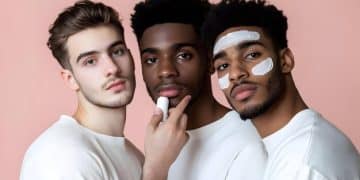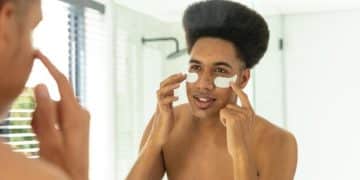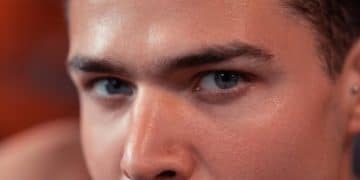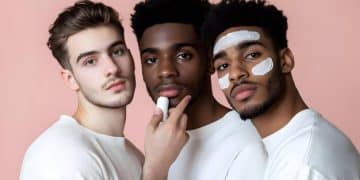K-Beauty’s Impact: Shaping Men’s Skincare in the US

Korean beauty trends have profoundly influenced the US men’s skincare market, introducing sophisticated multi-step routines, innovative ingredients, and a more holistic approach to skin health, shifting perceptions of masculinity in personal care.
The landscape of men’s grooming is undergoing a remarkable transformation, moving beyond basic soap-and-water routines to embrace a more sophisticated and proactive approach to skin health. Central to this evolution is The Influence of K-Beauty: How Korean Trends Are Shaping Men’s Skincare in the US, a phenomenon that has introduced innovative products, multi-step routines, and a refreshing perspective on self-care for men. What began as a niche interest has blossomed into a significant market force, compelling Western brands to adapt and innovate.
The Genesis of K-Beauty’s Global Ascent
The journey of K-Beauty from a regional cosmetic powerhouse to a global disruptor is a testament to its innovation, efficacy, and cultural resonance. South Korea’s beauty industry distinguishes itself through rapid product development, cutting-edge research, and a consumer base that demands constant evolution and results. This dynamic environment fostered a culture of skincare that views it not just as a routine, but as an investment in long-term skin health and well-being.
Pioneering Innovation and Ingredient Focus
K-Beauty’s rise was predicated on its ability to transcend traditional beauty norms. While Western markets often emphasized cover-ups and quick fixes, K-Beauty brought forth a philosophy of preventative care and treating skin from within. This approach was underpinned by a relentless pursuit of novel ingredients and formulations.
- Snail Mucin: Initially met with skepticism, this ingredient gained widespread acceptance for its regenerative and hydrating properties, becoming a staple in many K-Beauty products.
- Centella Asiatica (Cica): Known for its soothing and healing benefits, Cica has become a go-to for sensitive and irritated skin, now commonly found in both Korean and Western formulations.
- Propolis and Fermented Ingredients: These ingredients, leveraging natural processes, offer enhanced absorption and bioavailability, focusing on skin barrier health and anti-aging benefits.
The Multi-Step Routine: A New Paradigm
Perhaps the most defining characteristic imported from K-Beauty is the multi-step routine. What once seemed excessive is now understood as a layered approach to addressing various skin concerns comprehensively. This methodical process encourages mindful application and understanding of product benefits.
The typical multi-step routine, comprising double cleansing, toning, essence, serum, moisturizer, and SPF, educates consumers on the importance of each stage. For men, who largely adhered to minimalist routines, this presented a new level of engagement with their skin. It shifted the perception from skincare as a purely feminine pursuit to a gender-neutral self-care practice, accessible and beneficial for all. This paradigm shift was crucial in laying the groundwork for K-Beauty’s acceptance in the US men’s market. Many men found that investing a few extra minutes yielded significant improvements in skin texture, clarity, and overall appearance, reinforcing the value of this new approach.
Redefining Masculinity in Skincare
Traditionally, skincare for men in the US was confined to basic necessities: cleansers, shaving creams, and perhaps an aftershave. The mainstream depiction of masculinity rarely included elaborate grooming rituals. K-Beauty, with its emphasis on skin health regardless of gender, indirectly challenged these norms, paving the way for a more expansive understanding of male self-care.
Breaking Gender Stereotypes in Grooming
The influx of K-Beauty created a ripple effect, normalizing and even popularizing a more detailed and intentional approach to grooming for men. Korean celebrities and K-Pop idols, often showcasing flawless complexions achieved through rigorous skincare, became aspirational figures for younger generations globally. This cultural influence played a pivotal role in destigmatizing men’s involvement in beauty routines.
It showed that caring for one’s appearance, specifically skin, was not antithetical to masculinity but rather a form of self-respect and confidence. This was a significant departure from the rugged, no-fuss image often associated with Western male grooming. Products previously deemed “feminine,” like toners, essences, and sheet masks, began appearing in men’s routines, often marketed with gender-neutral packaging or even specifically for men. This subtle shift enabled men to experiment without feeling constrained by traditional gender roles.
The Evolution of Men’s Skincare Products
As the demand for more sophisticated men’s skincare grew, Western brands began to emulate the K-Beauty model. This involved not just incorporating new ingredients but also refining product textures, scents, and packaging to appeal to a male demographic that was becoming increasingly discerning.
Many brands started developing lighter, non-greasy formulations that absorbed quickly, addressing common male concerns like oiliness and congestion. The language used in marketing also evolved, shifting from addressing problems like “razor burn” to promoting concepts like “skin barrier health” and “anti-aging,” echoing the holistic approach of K-Beauty. This evolution signifies a fundamental change: men are no longer just looking to solve immediate skin issues but are interested in long-term skin maintenance and appearance. The notion that “good skin” is for everyone, regardless of gender, has taken root.
Korean Skincare Concepts Adopted by US Men
The influence of K-Beauty extends beyond individual products; it is about a holistic philosophy of skin health. US men have progressively adopted several core K-Beauty concepts, integrating them into their daily routines. This adoption marks a significant cultural shift in how men perceive and approach personal care.
The Double Cleanse Phenomenon
One of the most foundational K-Beauty practices to gain widespread traction among US men is the double cleanse. This method involves using an oil-based cleanser first to break down makeup, sunscreen, and sebum, followed by a water-based cleanser to remove any remaining impurities. While initially seemingly excessive, men quickly grasped the benefits.
The double cleanse process effectively tackles issues specific to male skin, such as excess oil production and clogged pores, which can lead to breakouts. It ensures a deeper clean, preparing the skin more effectively for subsequent treatment products. Many men found that incorporating this step significantly improved their skin clarity and reduced congestion, proving its efficacy beyond just removing makeup. The logic behind it – a thorough but gentle cleanse – resonated with those seeking genuinely healthier skin.
Embracing Multi-Layered Hydration
Beyond cleansing, the layering of hydrating products has become another cornerstone of men’s skincare, directly inspired by K-Beauty. This approach suggests that hydration is not a one-and-done step but a buildable process that infuses the skin with moisture at multiple levels.
Historically, men might have used a single moisturizer. Now, many are incorporating hydrating toners, essences, and even serums before their moisturizer. This multi-layered hydration strategy not only combats dryness but also contributes to a plumper, more resilient skin barrier. The subtle glow and softness achieved through this method have proven particularly appealing, replacing the stereotypical “rugged” dryness with a more refined, healthy appearance. This change indicates a deeper understanding of skin pathophysiology and a willingness to invest time in preventative care.
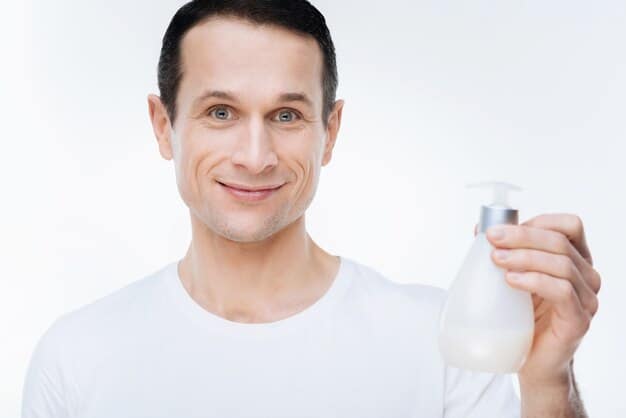
Impact on the US Men’s Skincare Market
The ripples of K-Beauty’s influence have become significant waves in the US men’s skincare market, transforming product offerings, retail strategies, and consumer expectations. This shift is not just a trend but a fundamental recalibration of what men’s grooming entails.
Market Growth and Product Diversification
The numbers speak for themselves. The men’s skincare segment in the US has witnessed sustained growth, partly fueled by the broadened interests inspired by K-Beauty. This expansion is visible in the sheer diversification of products available for men. What was once a limited aisle is now a burgeoning section, often mirroring the extensive offerings found in women’s skincare.
Brands are now launching men-specific lines that include essences, serums, sheet masks, and even specialized eye creams, all previously uncommon in Western men’s grooming. This diversification caters to new demands and educates men on targeted solutions for various concerns, from anti-aging to brightening and acne control. The market’s response demonstrates a recognition that men are no longer content with “one-size-fits-all” solutions. They seek customized, effective products that align with a more sophisticated understanding of skin health.
The Rise of “Skinimalism” and Ingredient Transparency
Interestingly, while K-Beauty introduced multi-step routines, it also fostered an appreciation for “skinimalism” – the idea of using fewer, but highly effective, products. This concept, often seen as a counter-movement to overly complex routines, resonated with men who appreciated efficacy without unnecessary steps. K-Beauty’s influence instilled a demand for products that deliver visible results efficiently.
Furthermore, K-Beauty has always been a proponent of ingredient transparency. Consumers, learning from the detailed ingredient lists and educational content surrounding Korean products, began to demand similar clarity from Western brands. This has led to a greater focus on clean ingredients, sustainable sourcing, and clear communication about what goes into a product. For men, who tend to be more pragmatic, understanding the “why” behind an ingredient often reinforces trust and willingness to incorporate a product into their routine. This push for transparency benefits not only men but the entire beauty industry, raising general standards.
Challenges and Opportunities for Western Brands
The rise of K-Beauty presents both significant challenges and lucrative opportunities for Western skincare brands operating in the US. Navigating this evolving market requires an understanding of consumer preferences and a willingness to adapt traditional approaches.
Bridging the Cultural Gap
One of the primary challenges for Western brands is successfully translating K-Beauty concepts for a US male audience without losing authenticity or alienating traditional consumers. K-Beauty often carries a unique aesthetic and marketing language that may not directly resonate with all segments of the US market. Brands must find a way to incorporate the efficacy and innovation of Korean methods while maintaining their own brand identity and cultural relevance. This means adapting packaging, scent profiles, and marketing narratives to appeal to a diverse range of American men, from the highly experimental to those just beginning their skincare journey.
It also involves educating consumers on the benefits of new ingredients and routines without overwhelming them. Simplified explanations and relatable examples are key to making sophisticated skincare accessible to a broader audience. The balancing act between aspiration and practicality remains crucial for market penetration.
Innovation in Formulation and Marketing
For Western brands, the opportunity lies in leveraging their existing market presence and understanding of local consumer needs to innovate effectively. This means not just copying K-Beauty products but adapting Korean innovations to Western preferences and regulatory environments.
- Hybrid Products: Developing multi-functional products that simplify routines while maintaining efficacy, appealing to men who seek efficiency.
- Sustainable and Clean Beauty: Integrating K-Beauty’s focus on natural and potent ingredients with the growing Western demand for clean and sustainable formulations.
- Personalized Solutions: Utilizing AI and data to offer personalized skincare recommendations, a concept often pioneered by tech-savvy Korean brands, adapted for the US market.
This innovation can extend to marketing, creating compelling narratives that emphasize long-term skin health and self-care rather than just addressing acute problems. Brands that successfully blend K-Beauty’s pioneering spirit with Western practicality and existing consumer trust are poised to thrive in this evolving landscape. They can capture the growing segment of men who are now more open to exploring advanced skincare solutions.
The Future Landscape of Men’s Grooming
The influence of K-Beauty is not a fleeting trend but a foundational shift that will continue to shape the future of men’s grooming in the US. As awareness grows and product accessibility increases, the market is poised for further evolution.
Continued Sophistication and Personalization
The days of generic men’s skincare products are rapidly becoming a relic of the past. The future will likely see even greater sophistication in formulations, driven by a demand for targeted solutions. Men will increasingly seek products that address specific concerns like hyperpigmentation, collagen loss, or unique sensitivities, moving beyond broad categories like “anti-aging.”
Personalization, already a growing trend, will become paramount. This involves not just customized product recommendations based on skin type or concerns but potentially bespoke formulations created through AI-driven diagnostics. As men become more knowledgeable about ingredients and their skin’s needs, they will gravitate towards brands that can offer tailored and nuanced advice. This shift reflects a deeper commitment to skin health as an integral part of overall well-being, rather than a superficial concern.
Integration of Wellness and Technology
The future of men’s grooming will also likely see a stronger integration with overall wellness. K-Beauty often emphasizes a holistic approach to beauty, linking skin health to diet, lifestyle, and mental well-being. This broader perspective is beginning to resonate with US men who are increasingly mindful of their health.
Furthermore, technology will play an increasingly vital role. Smart devices for at-home skin analysis, augmented reality tools for product testing, and apps for routine tracking could become commonplace. These technological advancements, often pioneered or heavily embraced in the Korean market, will make sophisticated skincare more accessible, demystified, and engaging for men. The synergy between high-tech solutions and high-efficacy ingredients, inspired by K-Beauty’s innovative spirit, will define the next generation of men’s skincare products and routines. The market will continue to expand, offering more diverse, effective, and ethically produced options, ultimately benefiting the consumer.
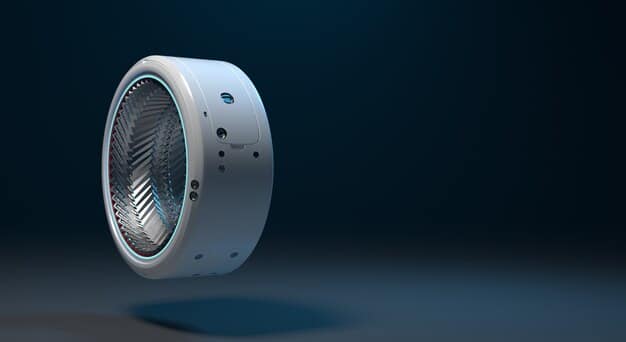
| Key Point | Brief Description |
|---|---|
| 🇰🇷 K-Beauty Influence | Korean beauty introduced innovative products and multi-step routines to the US men’s skincare market. |
| 🔄 Redefining Masculinity | Challenged traditional male grooming norms, normalizing comprehensive self-care for men. |
| 💡 Market Innovation | Led to market growth, product diversification, and a demand for ingredient transparency in Western brands. |
| 🌐 Future Trends | Future of men’s grooming involves greater personalization, integration with wellness, and tech adoption. |
Frequently Asked Questions About K-Beauty and Men’s Skincare
K-Beauty’s influence stems from its emphasis on innovation, efficacy, and a holistic approach to skin health, shifting traditional perceptions of masculinity in grooming. It introduced advanced ingredients and comprehensive multi-step routines previously uncommon in Western male skincare, making complex regimens accessible and desirable.
US men have widely adopted practices like “double cleansing” for a thorough clean and “multi-layered hydration” using toners, essences, and serums to deeply moisturize. These techniques, once considered niche, are now recognized for significantly improving skin texture, clarity, and overall health beyond basic routines.
K-Beauty challenged the notion that advanced skincare is exclusively feminine. By showcasing flawless complexions on male K-Pop idols and emphasizing healthy skin for everyone, it normalized men’s engagement with sophisticated routines. This helped redefine masculinity to include self-care and attention to appearance, fostering greater confidence.
Yes, Western brands are increasingly adapting by diversifying their men’s product lines to include essences, serums, and masks, and by focusing on ingredient transparency. They are also developing hybrid products and personalized solutions that blend K-Beauty’s innovation with Western preferences for efficiency and clean formulations.
The future of men’s skincare will likely feature greater personalization, with more targeted formulations and AI-driven recommendations. There will also be a stronger integration of skincare with overall wellness and the adoption of advanced technologies for at-home analysis and improved routine tracking, ensuring continued growth and evolution.
Conclusion
The transformative influence of K-Beauty on men’s skincare in the US is undeniable. It has moved the conversation from rudimentary daily washing to a nuanced embrace of multi-step routines, innovative ingredients, and a philosophical shift towards proactive skin health as a form of self-care. This cultural exchange has not only broadened product offerings but also expanded the very definition of masculinity, demonstrating that commitment to skin well-being is universal. As K-Beauty continues to inspire and evolve, the future of men’s grooming promises an even more sophisticated, personalized, and technology-driven landscape, forever altered by the groundbreaking trends from South Korea.
